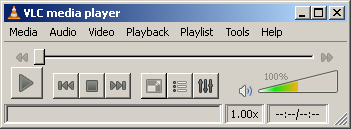Documentation:VLC for dummies
Contents
VLC for dummies
Introduction
Thank you for visiting this page to find out what VLC is about. Please note that this page is in construction and might change in a near future. VideoLan Client (or VLC for short) is an free and open source software media player. Features that make VLC the preferred media player for a lot of people is its excellent support for various audio and video codecs, the fact that it is cross platform and the open way of development.
This page will describe the steps to perform the basic steps of using VLC. For more advanced uses see the VLC Play HowTo for a complete user guide, or VLC Streaming HowTo for the advanced streaming features that VLC is capable of.
Understanding the VLC interface (in progress)
When you start VLC, two things will change on you screen. First there will appear a small icon in your taskbar (note that these screenshots are taken from the MS Windows XP version, on other systems they might appear slightly different):
The other, more prominent change to your screen will be the appearance of the main interface:
The icon in your taskbar can switch the main interface on or off by left clicking on to it. Also, if you close the main interface by using the close button in the window, you will be able to open the screen again by using the icon in the taskbar. Features like stopping or pausing playback or change track are also possible by right clicking the icon. This will give a popup menu where you can perform your wanted action.
The main interface contains a couple of sections:
Menu bar
The menu bar in the top provides easy access to all features that VLC is capable of.
Track slider
Just below the menu bar is the track slider. It will progress during playback of a song or video from left to right. When playing a video, the video will be displayed between the menu bar and track slider. When reading a stream the track slider will not progress as VLC can't know how long the stream will take.
Control buttons
Below the slider, to the left of the interface, are the control buttons for play/pause, previous track, stop, next track, fullscreen mode, playlist and extended options.
Volume control
To the right of the control buttons is the volume control. The small speaker icon is a button to quickly mute or un-mute all sound. The slider to the right of it allows you to modify the volume to louder or softer. The percentage gives the amount of amplification.
Data field
In the bottom of the window, some additional information, like track name and length of the track, will be displayed for convenience.
Playing a media file (to be written)
Basic steps to play an audio file or movie.
